Thessaloniki’s Long-Awaited Transformation Takes Shape
From major infrastructure projects to a...

The Kourtis vineyards in Pieria and, in the background, majestic Mt. Olympus.
Northern Greece is a thrilling wine region stretching from the boundaries of Thrace in the east to the western outskirts of Macedonia. And while most wine enthusiasts may be familiar with the impressive success of the vineyards in Drama and Kavala, the first places in Greece that invested in blends of international and native varieties, and later in varietal Xinomavro wines from Naoussa and Amyndeo, there are a number of new things to get excited about in three other regions as well.
In Goumenissa, Kilkis, in the northern part of Macedonia, just an hour’s drive from cosmopolitan Thessaloniki, the countryside is stunning, with gently rolling hills that reach 450 meters in elevation. The area has been producing wine since the late 19th century and currently has approximately 300 to 400 hectares of planted vineyards. Here, a fascinating terroir for Xinomavro is emerging, but another local hero is on the rise, too, a deep-colored grape variety called Negoska that plays an integral part in the Goumenissa PDO blend, adding color, alcohol and tannins while lowering overall acidity.
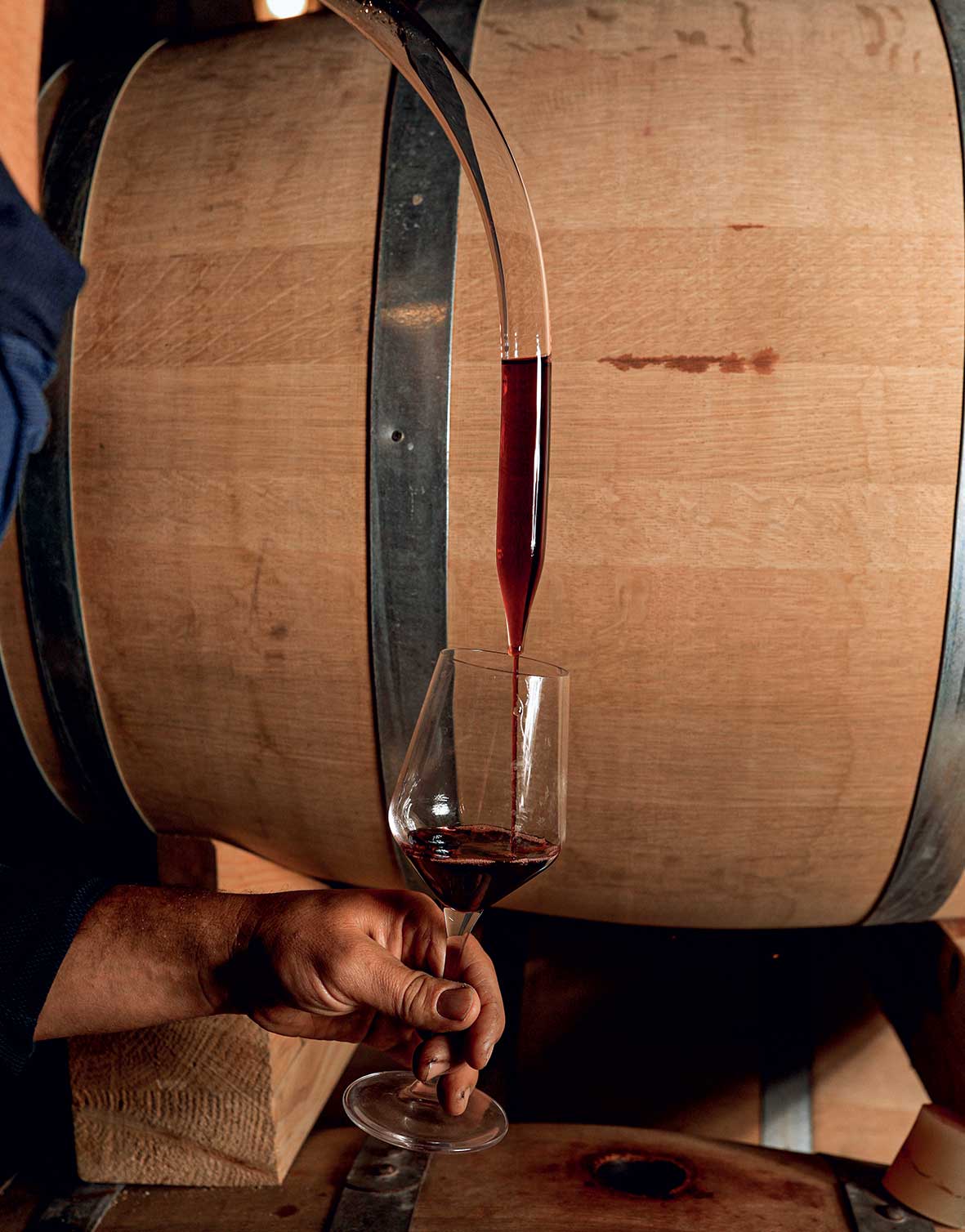
Taking a tasting sample straight from the barrel with a wine thief at Estate Chrisostomou in Pieria.
© Konstantinos Tsakalidis

The winemaker Chloe Chatzivaryti at the family winery in Goumenissa.
© Alexandros Avramidis
“It is an area with a prosperous future,” says Chloe Chatzivaryti, a talented winemaker who, while following in her father’s footsteps at Chatzivaryti Winery, has brought a new approach to viticulture to the family enterprise, emphasizing natural winemaking and planning to fully convert to biodynamic farming. “Negoska is a challenge, as it’s hard to balance the high tannic load with its low acidity. That’s why it’s often blended,” she says.
Another important change came to Goumenissa when one of the leading Greek wineries, Biblia Chora, invested in the region, acquiring Titos Eftihidis Winery and renaming it Mikro Ktima Titos. “Goumenissa has lots of potential” says producer Vasilis Tsaktsarlis of Mikro Ktima Titos. “We want to make the region great again, by investing a lot in the individuality of Negoska,” he says, adding that progress towards single-variety success for that grape will need meticulous viticulture, controlling yields and sourcing fruit from old vines.
Other noteworthy Goumenissa estates are Aidarini Winery, producing classically structured reds, Domaine Tatsis, a pioneer in natural and biodynamic wines, of course, the renowned Boutari Wines, which first invested in the region way back in the mid-’70s.
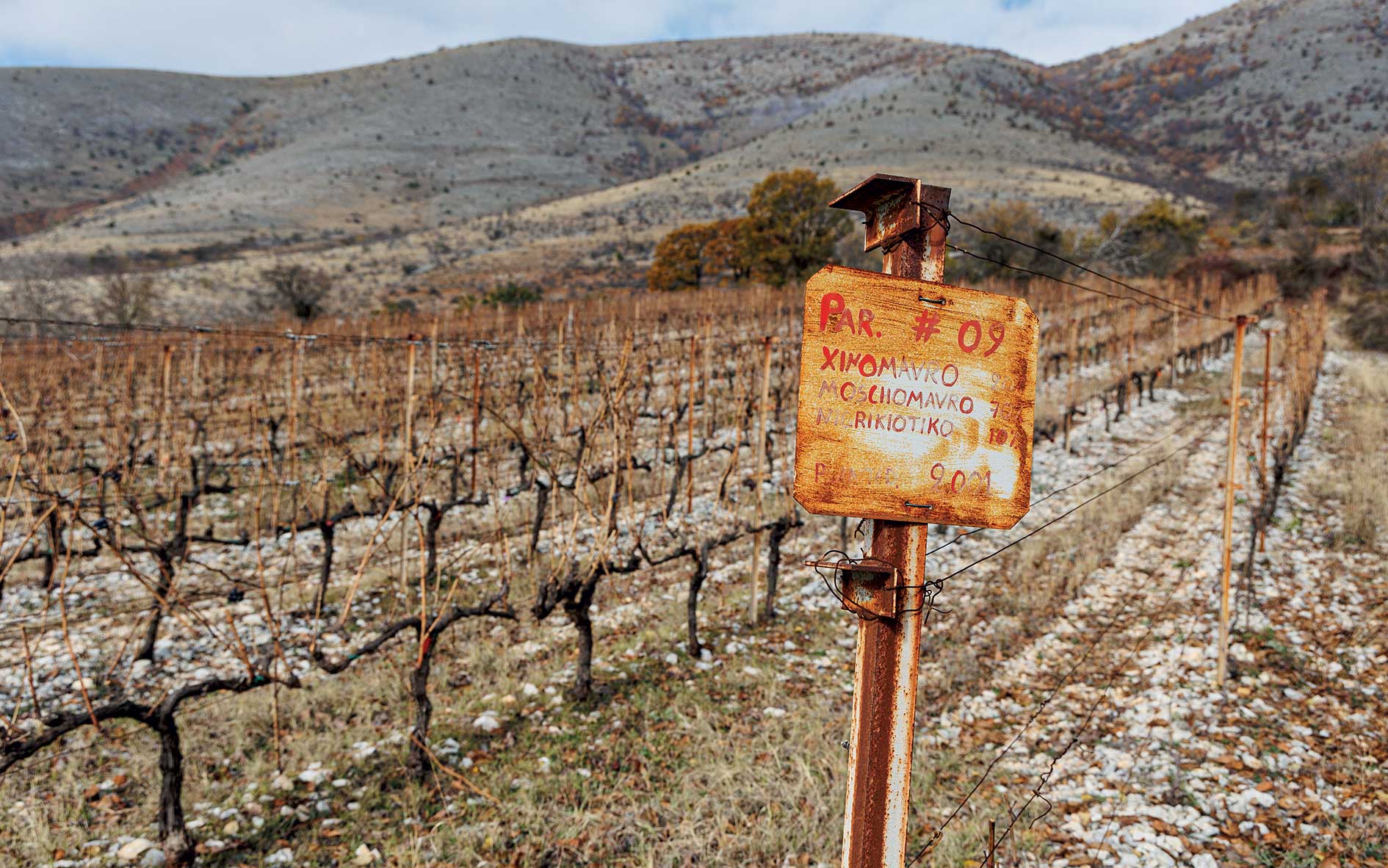
Old vines in Siatista that produce Xinomavro for Magoutes Winery
© Konstantinos Tsakalidis
Moving west, there is an unsung terroir between the cities of Kozani and Grevena that could have been a PDO but was lost in the mists of Greek legislation. Siatista is home to some of the best, if as yet unheralded, sweet wines in Greece. Some of the first references to these wines, known as “iliasta,” date to the early 19th century. These wines are still being produced in the traditional manner today, by drying the grapes indoors rather than by sun-drying, just as is done for Tuscany’s Vin Santo. The drying period lasts two months or longer, depending on the desired sugar levels in the wine.
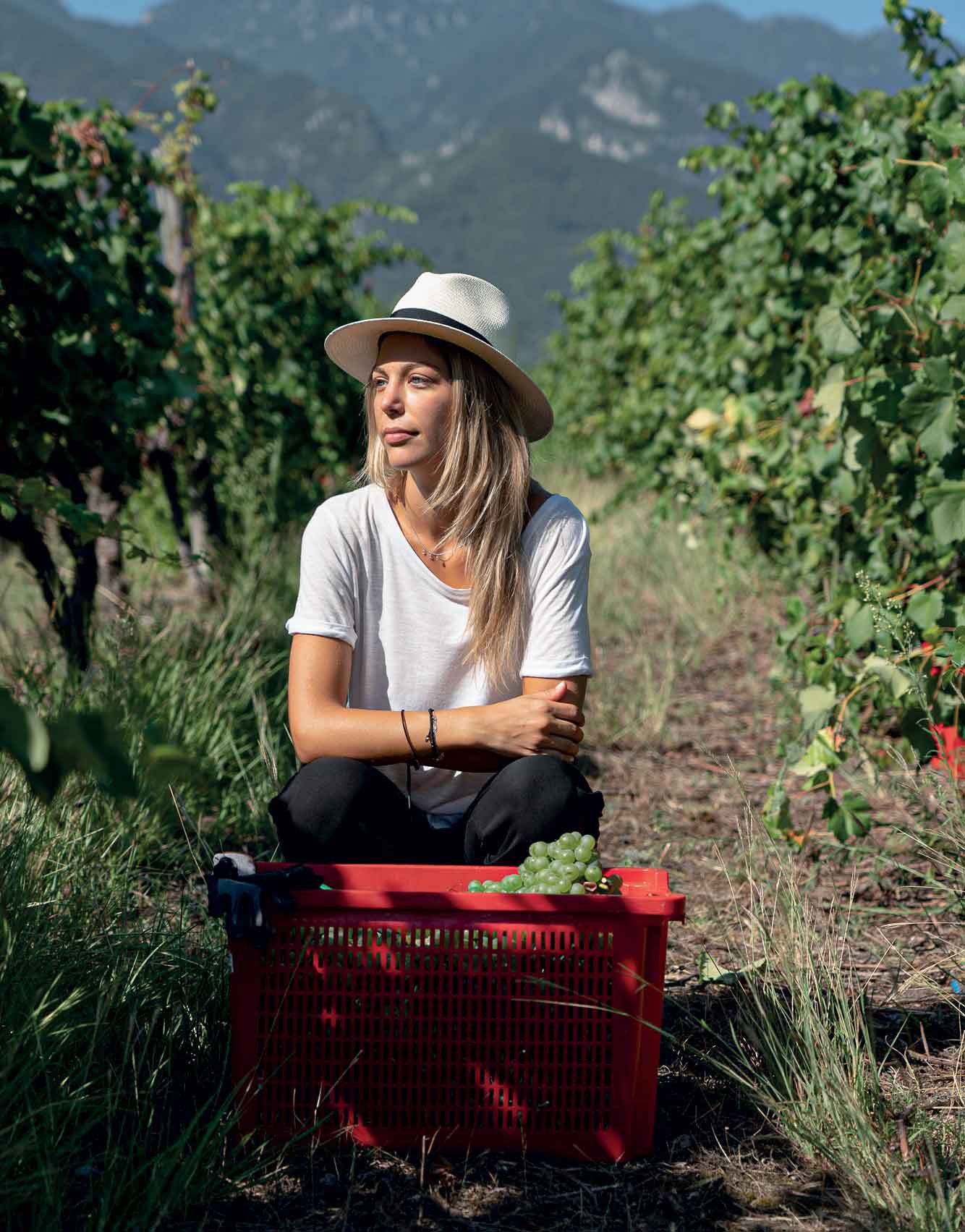
Winemaker Maria Dimitriadi of Navitas Winery in Pieria.
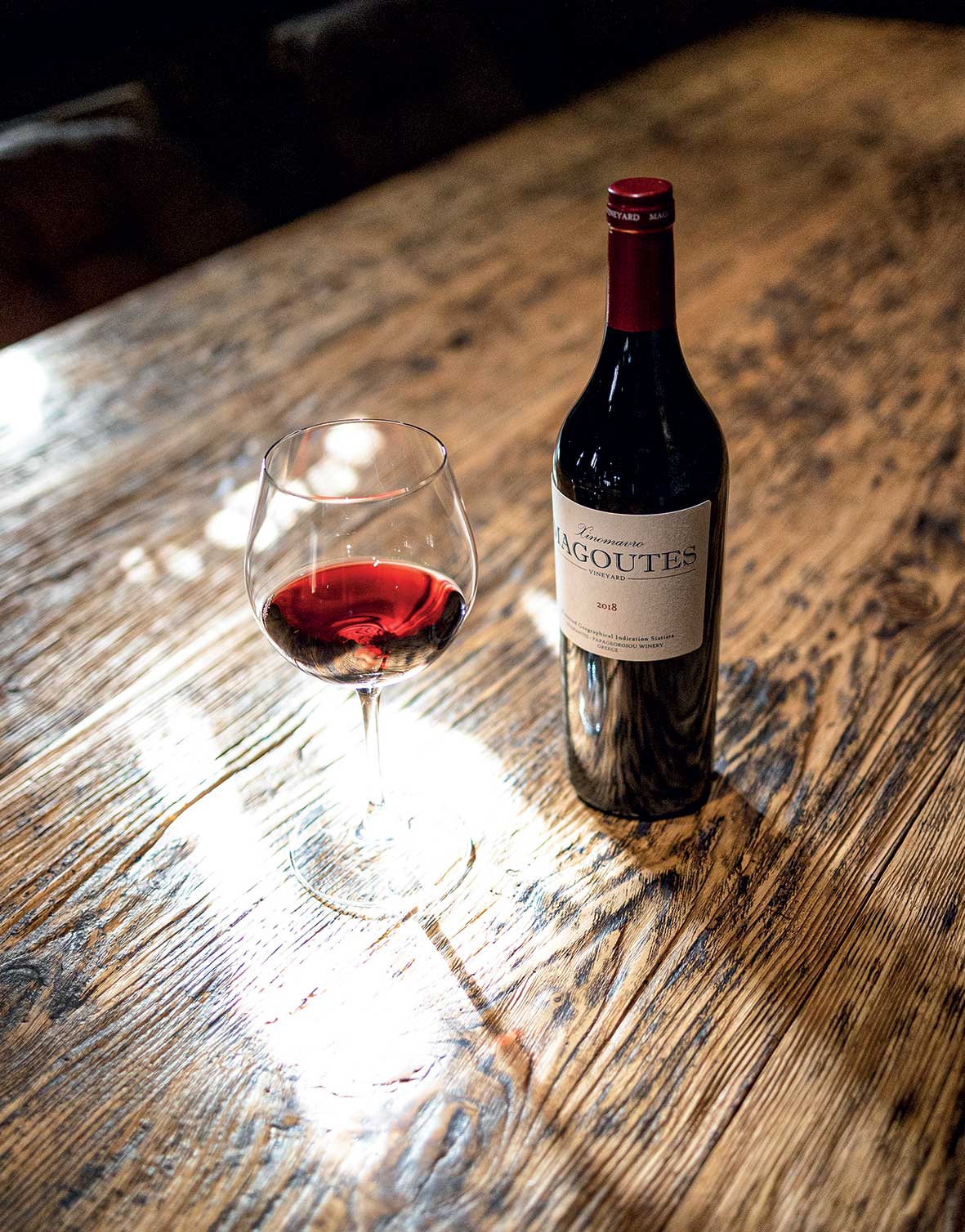
A bottle of Xinomavro from Magoutes Vineyard.
© Konstantinos Tsakalidis
In the region of Siatista, Dyo Filoi is a winery currently focused on sweet wines but increasingly investing in Xinomavro, Moschomavro, Pinot Noir and Riesling. Its neighbor Magoutes Vineyard makes thrilling wines from Xinomavro and the delicately scented local variety Moschomavro. Here, the winemaker Dimitris Diamantis has plans for expansion; at present, the vineyards of Siatista have shrunk to a total area of 350 hectares, with ancient vines of 70-100 years old making up a significant part ( some 70%) of the planted vineyards, which can be found as high up as 900-950 meters above sea level. “My vision is to help save Siatista’s traditional indigenous varieties. The main problem is that, for most people here, viticulture was done on an amateur basis; most locals were traditionally engaged in the local fur business,” he says. “Another problem was those big companies that showed interest in the region wanted to plant international varieties. They uprooted very old vines in favor of varieties like Sagrantino and Rondinella,” he says.
The region of Pieria in the southern reaches of Macedonia sits in the shadow of Mt Olympus and on the edge of the Pierian Mountain Range, where the terroir is influenced both by the mountains and by the sea. More than a dozen wineries are bringing out the best that the region offers, forging an identity for the area based partly on indigenous varieties.
Kitrvs Winery, in the lowlands of Pieria, makes deliciously fruity yet complex Malagousia and experiments with interesting international varieties such as Aglianico and Verdicchio. Kourtis Winery is an artisanal estate producing wonderful wines from both local and international varieties, including Vidiano and Trebbiano. Its Oinovion label blends Cabernet Sauvignon, Merlot, Xinomavro and Agiorgitiko. The total annual production of this winery is 20,000 bottles at most. Estate Chrisostomou, on the other hand, produces close to 50,000 bottles from 11 hectares in the Pydna area. Their fruity Moussaios Assyrtiko has mineral notes and ages very well; the red Moussaios, a blend of Xinomavro and Limniona, has a full bouquet, and is well structured and delicious.
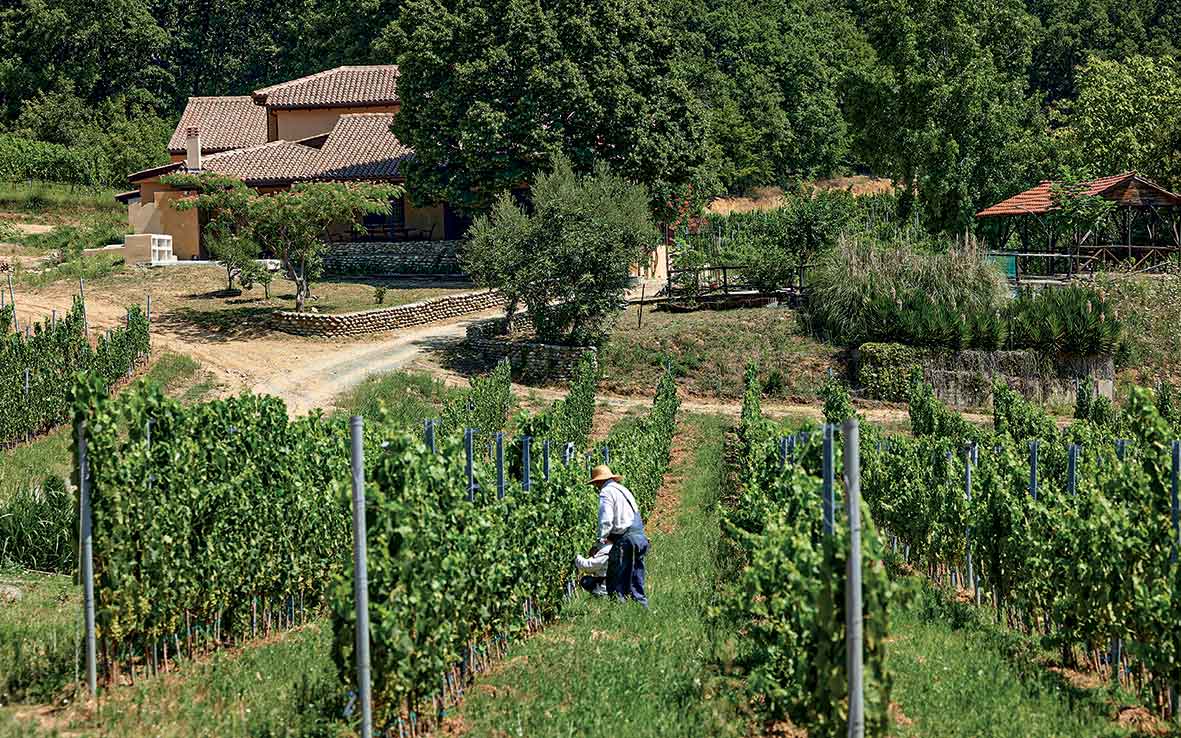
In the vineyards at Mikro Ktima Titos in Goumenissa.
The latest addition to the area is Navitas Winery. There, Maria Dimitriadis and her expert team focus on organics to render clear expressions of Xinomavro and Assyrtiko, fruity and pure for the former and crystal clear, with a lean and saline character, for the latter. Total production is no more than 10,000 bottles.
There are, of course, more wineries and winemakers doing fine work in the area. Nadir Winery, Papagiannoulis Winery and Pieria Erateini all produce wines that reflect this promising area’s unique terroir.
Despite a wine tradition dating back to ancient times, these areas are still evolving, drawing strength from what nature has given them. Time will tell just where they fit in on the Greek wine scene but, based on present evidence, they certainly bear watching.
Xinomavro: Octopus cooked in red wine, with orzo and tomatoes, because the wine goes well with the acidity of the tomatoes. Another great choice, and a classic in its own right, are lamb chops, which cry out for tannins and acidity to “cleanse” their fat. For a mature bottle of Xinomavro, a truffle risotto is perfect, as the wine delivers similar aromatics.
Mainland: Assyrtiko For the full-bodied, creamy Assyrtiko from this region, a prime grilled fish or even white meat, such as lamb fricassée. Cream-based dishes that include white meat, such as chicken or pork, will also work well.
Negoska: Less acidic dishes than for Xinomavro. Meat dishes and other hearty food make good matches.
Chatzivaryti, Goumenissa
Chloe Chatzivaryti, Spin Negoska
Aidarinis, Goumenissa
Tatsis, Goumenissa
Mikro Ktima, Goumenissa
Magoutes, Xinomavro Parcel Selection
Dyo Filoi, Kelari Tapnou
Kourtis Winery, Trebbiano
Chrisostomou, Moussaios Red
Navitas, Xinomavro
Kitrvs, Malagousia
From major infrastructure projects to a...
A challenging summer ride across the...
From the fall of a monarch...
Why not try a brief getaway...